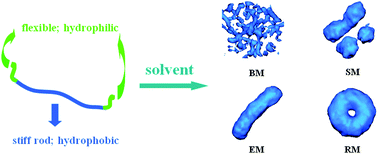Complex micelles from the self-assembly of coil-rod-coil amphiphilic triblock copolymers in selective solvents
Abstract
We report an extensive simulation study on the spontaneous formation of complex micelles from coil-rod-coil amphiphilic

* Corresponding authors
a
CAS Key Laboratory of Soft Matter Chemistry, Department of Polymer Science and Engineering, University of Science and Technology of China, Hefei, Anhui, People's Republic of China
E-mail:
xjli7@ustc.edu.cn, hjliang@ustc.edu.cn
b Hefei National Laboratory for Physical Sciences at Microscale, University of Science and Technology of China, Hefei, Anhui, People's Republic of China
We report an extensive simulation study on the spontaneous formation of complex micelles from coil-rod-coil amphiphilic

 Please wait while we load your content...
Something went wrong. Try again?
Please wait while we load your content...
Something went wrong. Try again?
P. He, X. Li, M. Deng, T. Chen and H. Liang, Soft Matter, 2010, 6, 1539 DOI: 10.1039/B926370E
To request permission to reproduce material from this article, please go to the Copyright Clearance Center request page.
If you are an author contributing to an RSC publication, you do not need to request permission provided correct acknowledgement is given.
If you are the author of this article, you do not need to request permission to reproduce figures and diagrams provided correct acknowledgement is given. If you want to reproduce the whole article in a third-party publication (excluding your thesis/dissertation for which permission is not required) please go to the Copyright Clearance Center request page.
Read more about how to correctly acknowledge RSC content.
 Fetching data from CrossRef.
Fetching data from CrossRef.
This may take some time to load.
Loading related content
